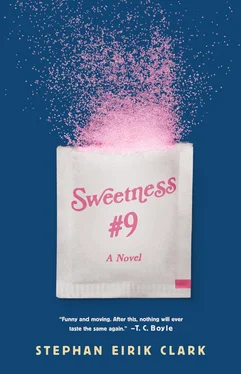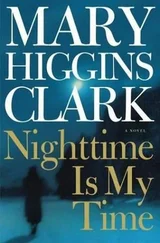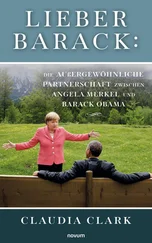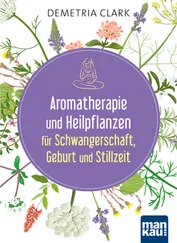I nodded patiently for as long as I could, then finally broke in. “Yes, yes, I know, Beekley, I’ve read the same stories in Time and Newsweek. ”
“Then you’ll know the smart ones have already built a bunker in Montana. We’re not talking about a weekend trip to Atlantic City here. It’s the end of the world as we know it. Takes a little planning, doesn’t it?”
“Fine, of course, I’ll mention it. I’ll even bring in a can of pumpkin pie filling tomorrow if you’ll first relieve me of this field trip today.”
He made a face that told me his thinking on this matter hadn’t changed.
I threw my finger out at him. “You need to start pulling your weight around here. Even da Vinci had busywork, you know.”
He lay back, lifting his magazine over his head.
“And when you come in tomorrow, I expect to see that lab coat ironed. Do you hear? You’re one splash of red food coloring away from looking like a Mexican butcher.”
“Word of advice, David.” He turned the page of his magazine. “Don’t turn your back on those kids, and by all means — shoot first.”
After turning out into the hall and hearing voices still coming from the test kitchen, I made my way toward the door of the flavor development studio, thinking to ask one of the other two flavorists on staff to cover for me.
My long-time colleague “Tennessee” Terrence Matthews was out of the question, for in addition to having five years of seniority on me and being a master of sweet-brown confectionery flavors (you’ve never tasted a better butterscotch), he was, as Beekley liked to say, “an old-school flavor chemist,” uninterested in anything outside of the hard sciences. Just in the last year alone, with one eye on an adjunct teaching position in his retirement, Tennessee had returned from a five-month stay in Israel, where as a Fulbright Scholar he’d collected and synthesized the essential oils of the Biblical World — many endangered, some previously believed extinct. For this feat of exploration and taxonomy, Perfumer & Flavorist magazine had awarded him its cover (and we had given him a nickname, “Mr. May,” which he had tolerated for all of one day). Yes, asking Tennessee to lead a field trip was out of the question. It would be like asking a leader of the women’s movement to babysit your kids. Even if I knew the answer would be yes, I wouldn’t be able to sit through the explication leading up to it.
My best hope was our newest hire, a Sri Lankan native who’d begun his studies in chemistry at the Technical University in Munich, continued them at Leeds in England, and finally ended up right here in the United States, pursuing a Ph.D. in food chemistry with a concentration in sensory evaluation at none other than Cornell. Those of us at FlavAmerica had tried to learn the most basic rhythms and intonations of this young man’s native tongue, but we’d found all five of his given names incompatible with our ingrained speech patterns. Consequently, we’d shorn just a fragment off of one of those names (Kobalavithanage) and, in part because he had such an impressive mustache, took to calling him by Stalin’s nom de guerre: Koba.
When I turned in to the flavor development studio, Koba was unbuttoning his lab coat so he could more freely fiddle with his fly. “Don’t know where the bugger popped off,” he said. “But I suppose I’d be off my trolley to question the craftsmanship of these trousers. I’ve put on more than one stone since coming to America.” He looked to Tennessee, who stood at his work station using a spring clamp to hold a test tube in a pot of boiling water. “You wouldn’t happen to have a hair grip, would you?” Getting no response, he turned to me. “How about you, David? I’d hate for Ernst to come in and see me with my John Thomas hanging out.”
Tennessee was a good old boy with a high head of dyed black hair and a mouthful of new white teeth. “I reckon there were a half-dozen words in there I didn’t un’erstand,” he said. “Can you remind me again why we hired a man doesn’t speak a lick of goddamn English?”
Koba had me to thank for that. Nine months previous to this, Ernst Eberhardt had given me a letter he had received from him requesting an informational interview. I agreed to meet Koba at a buffet restaurant on the other side of the Stupfer Bridge, thinking I’d do little more than split the check and point him in the right direction. But he was such a brave eater, I couldn’t help but take notice. He combined pungent Asian sauces with Swedish meatballs, mixed his mashed potatoes with guacamole and yellow mustard, and ate no one part of his meal separate from another.
He smiled shyly when he noticed me observing this. “I tell my wife it’s to broaden my palate and experience new taste sensations,” he said, “but I’m afraid she still refuses to dine with me in public.”
After watching him bite into a piece of sheet cake topped with a jalapeño pepper, I’d seen more than enough. “You just put yourself onto a very short list, young man.” I reached for the check, waving off his efforts to split it. “A very short list indeed.”
Later, I explained to Ernst that our needing him was not just a question of diversifying the workforce. “I know you’ll take on any man, woman, or robot who can do the job. But you must ask yourself, with Thai, Indian, and other emerging cuisines becoming more prominent in the marketplace, how can we really be sure we understand what the average American wants to eat? Why, even Wendy’s is serving a chipotle hamburger these days. And it’s not the survival of the fittest, remember. It’s he who can adapt.”
With my mentor’s approval, we brought Koba on board that winter and lifted his probationary status in the spring after some basic sensory testing had confirmed he had the mouth and the nose for the job. He was nothing if not professional. He never wore a distracting cologne or lotion, and he never complained about being the first one in each morning or the last one out at night. How many times had I stopped on my way to the parking lot and seen him sitting on his stool in the flavor development studio, flipping through Heath’s Source Book of Flavors or Steffen Arctander’s seminal study on the uses of essential oils? He wasn’t one of these wild-haired young men drunk on theory. He studied our Bible, the book listing the ingredients of all our in-house flavorings, and understood it’s sometimes wiser to carpool than to reinvent the wheel.
Most impressive was the marbled notebook in which he recorded his thoughts on the raw materials he encountered while standing across from me each day in the lab. After smelling one, he’d jot down his impressions of its odor, taste, strength, and lasting power on a blotter, then note its kosher status, cost, and supplier, as well as any peculiarities relating to its regulatory status both here and abroad. This is no small matter, for while there are but four basic tastes in this world (sweet, sour, salty, bitter), there are some four thousand different aromatic impressions (browned, fatty, rancid, pungent, to name just a handful associated with cooked beef) along with a host of trigeminal sensations — grainy, warm, soft, painful, etc. — that can further influence any flavor.* Only by encountering each of these aspects in the lab — and learning how to describe them in a language shared by your co-workers — can a flavorist build up the type of vocabulary needed to discuss the products of the profession, be it a flavor as simple as your basic six-note cherry or a more complex and elusive blend involving no fewer than one hundred volatile aromatic molecules.
If there was one problem with Koba, it was, as Tennessee was quick to remind me, his very foreignness. Since leaving his native Colombo at the age of seventeen, he had become more British or European than American. His sense of cultural drift didn’t make him in any way unique at FlavAmerica. I had been raised in England, of course, and Beekley had circumnavigated the globe as an army brat. But we had assimilated, and Koba clearly had not, as we all could see the first time he looked at the sign above the door to the flavor development studio — ASK NOT WHAT YOUR COMPANY CAN DO FOR YOU, ASK WHAT YOU CAN DO FOR YOUR COMPANY — and didn’t get the reference.
Читать дальше












